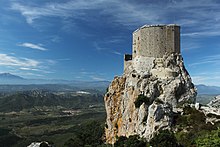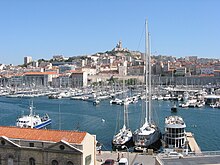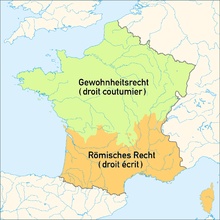South France
Southern France ( French le Midi de la France or just le Midi , Occitan Miègjorn ) can - depending on the delimitation - include approximately the southern half of France or only part of it. In the narrower sense, only the part is meant that is south of the 45th parallel .
Midi (pronunciation [mi'di] , stressed on the second syllable, literally ' noon ' or in a figurative sense ' south ') is the French-speaking geographical technical and general term; the expression has also found its way into German geographical technical and everyday language.
Location, landscape and geographic differentiation

Southern France in the narrower sense includes the area of the Provence-Alpes-Côte d'Azur and Occitania regions , as well as the Aquitaine region that existed until 2015 (today part of Nouvelle-Aquitaine ) and the south of the former region of Rhône-Alpes (today part of Auvergne-Rhône -Belonging to the Alpes ). In a broader sense, the rest of Auvergne-Rhône-Alpes and most of the rest of Nouvelle-Aquitaine (south of the Poitou threshold and La Rochelle ) and the island of Corsica can also be included.
After Spain and Andorra , southern France is delimited by the natural border of the Pyrenees , to the east with Italy by the southern western Alps . The Bay of Biscay and the Gulf of Lion form the sea borders.
The northern border is not clearly defined. The 45th parallel is often given. It runs a little north of Bordeaux through the confluence of the Garonne and Dordogne in the Gironde funnel, the headwaters of the Loire in the Massif Central , the city of Valence on the Rhône and the Barre des Écrins in the French Alps . Accordingly, a French proverb reads “ c'est à Valence que le Midi commence ” (“The south begins at Valence”). It is generally assumed that from Valence as the “ porte du Midi ” (“Gate of the South”) the Mediterranean influence becomes noticeable. On the other hand, La Rochelle , located much further north, is sometimes referred to as the “gateway” to the Midi atlantique ; and the Poitou threshold (seuil du Poitou) , which separates the Paris Basin from the Aquitaine Basin , is a traditional point of contact between the northern and southern French cultural areas. The northern border of the Midi would therefore run roughly along the line La Rochelle - Clermont-Ferrand - Lyon - Lake Geneva . In the Ancien Régime (i.e. until the French Revolution of 1789), this also separated two different legal systems : in the south the tradition of Roman law (pays de droit écrit) applied , while in the north Franconian- influenced customary law was applied (pays de coutumes) .
Geographically, Le Midi is further differentiated:
- Le Midi atlantique 'the Atlantic South of France', d. H. the southern French Atlantic coast, parts of the Charente and Charente-Maritime , as well as the Limousin , the historic provinces of Perigord , Guyenne , Gascogne , Béarn , and the French Basque Country in the western Pyrenees
- Le Midi méditerranéen 'the Mediterranean south of France', d. H. the regions of France that are part of the Mediterranean , i.e. the Maritime Alps , Provence with the Côte d'Azur and the Provencal Alps, the lower Rhone Valley with the Rhone Delta , Languedoc and Roussillon .
In this sense, the plural of Les Midis (français) , i.e. H. different parts of southern France, spoken if one means all southern landscapes of France.
The east is characterized by the Mediterranean climate , the west has an Atlantic character. In the biogeographical context, the Méditerranéen is separated from the rest of France and the Midi atlantique by the olive tree border . Midi is primarily understood to mean the small chamber of southern France in a multitude of sub-Mediterranean-Atlantic and Mediterranean regional climates. Common link between the climate differentiated landscape was up to the phylloxera crisis of viticulture .
In terms of linguistic and cultural geography, the midi in the narrower sense largely coincides with Occitania , i.e. the distribution area of the Occitan language ( Langue d'oc ), as well as the smaller language areas of Catalan and Basque far in the Pyrenees south of France. The wider definition of southern France also includes the Franco-Provençal (Arpitan) language area in the (south) east and Saintongeais in the west. Today, these languages have been replaced by (standard) French in many places, which is sometimes spoken with a different accent.
Important cities and cultural or economic centers in the Midi are the port metropolis of Marseille , the Provencal cities of Avignon , Aix-en-Provence and Toulon , Nice and Cannes on the French Riviera, Nîmes , Montpellier , Toulouse (the former capital of the historical province of Languedoc) and the historic fortress city of Carcassonne in Languedoc, Perpignan in Roussillon (Catalonia), Bordeaux in Aquitaine and Bayonne in the Basque Country - in a more generous way also Angoulême and Limoges .
Le Midi in history, linguistics and culture
Early history
From a prehistoric point of view, the area is divided into different regions, some of which left their own forms of megalithic evidence ( Dolmen des Fados ). Most of them are likely to belong to the Chassey-Lagozza-Cortaillod culture . There are two regions with statue menhirs (Languedoc, Rouergates) and eight dolmen areas ( Aquitaine , Ardèche , Grands Causses , Languedoc, Minervois , Pays Basque , Quercy and Roussillon). Some menhirs and the cromlechs (e.g. Lacam de Peyrarines ) are also of considerable size.
Antiquity
Parts of the French Mediterranean coast were colonized by the Greeks in ancient times . The cities of Nice (Nikaia), Antibes (Antipolis), Marseille (Massalia) and Agde (Agathe) were originally Greek foundations in the 7th and 6th centuries BC. The areas of southern France near the Mediterranean came into being in the 2nd half of the 2nd century BC. BC under Roman rule and formed the province of Gallia Narbonensis , the rest of Gaul , however, was only around 50 BC. Conquered in the Gallic War under Gaius Julius Caesar of Rome. As a result, the south was significantly more penetrated by Roman culture and language than the north, where the Celtic element could last longer . The Atlantic south was organized as the province of Gallia Aquitania .
The Roman character persisted even after the Great Migration , when various Germanic groups moved through Gaul and some of them also settled. Most of the south of France belonged to the Visigothic Empire in the 5th and 6th centuries , also known as the Tolosan Empire after its capital, Tolosa (today's Toulouse). The Rhône Valley and today's French Alps belonged to the empire of the Burgundians at the turn of the 5th and 6th centuries . The area later known as Provence belonged to the Ostrogoth Empire from 493 , which emerged from the rump of the Western Roman Empire and in which the Roman administrative structures essentially continued. In the Battle of Vouillé 507 the Franks defeated the Visigoths decisively and large parts of southern France (especially Aquitaine) came to the Frankish Empire . In 534, the Franks also conquered the Burgundy Empire , which became the Franconian part of Burgundy . When the Ostrogoth Empire fell apart, Provence also became part of the Franconian Empire in 536. Only Septimania (which roughly coincides with the later Languedoc and Roussillon) remained with the Visigoth Empire, whose center was now in Toledo , Spain , until it was conquered by Arabs and Berbers ("Moors") in 725. These were pushed back behind the Pyrenees in 752, so that this area also became part of the Franconian Empire.
middle Ages
While in the early Middle Ages under Frankish rule the Roman civitates in the north-east were replaced by a Franconian district constitution ( Pagus zone), in the south the political and social structure of the civitates essentially remained . The Christian bishops now often took the place of the Roman governors. After the Treaty of Verdun (843), the west of what is now southern France became part of western France , the east part of the "Middle Kingdom" ( Lotharingia ) and later the Kingdom of (Lower) Burgundy .
The predominant language in southern France in the Middle Ages was from the local Vulgar Latin emerged (old) Occitan (inaccurately also called Old Provençal). The name of this language, langue d'oc , was derived from the word òc (from Latin hoc ) for "yes", while in the northern and central French dialects oïl and later oui for "yes" were used and this form of language (ie the medieval forms of today's français ) was designated accordingly as langue d'oïl . The langue d'oc was widespread as a courtly cultural language as far as northern Spain and Italy and played an important role in medieval trobadord poetry .

In the 12th to 14th centuries, the religious movement of the Cathars ( also called " Albigensians " after the town of Albi in Languedoc ) had a great influence in Occitania . They were overthrown at the instigation of the French king, who wanted to expand the crown domain to the south, and the Catholic Church through the Albigensian Crusade , other campaigns and the Inquisition. Numerous strongly fortified hilltop castles, the Cathar castles, date from this time .
Important rulers in the area of southern France in the high Middle Ages were the county of Toulouse together with the Duchy of Narbonne , which became a crown domain as early as 1271, i.e. were in the direct possession of the French kings, and formed the province of Languedoc ; and the Duchy of Aquitaine , which belonged to the House of Anjou-Plantagenêt and, like the entire western half of France and England, belonged to the so-called " Angevin Empire ", but after the defeat of the Plantagenets in the Franco-English War at the beginning of the 13th century, it was divided into the counties or The duchies of Guyenne and Gascony fell apart, both of which finally fell to the Crown Domain in 1453. The Dauphiné (actually the Delphinat of Vienne ) and the county of Provence belonged as part of the Kingdom of Burgundy / Arelat, at least formally to the Holy Roman Empire , but the Dauphiné was incorporated into the Kingdom of France in 1349 , while Provence was actually owned by the House of Valois-Anjou French influence came before the French kings formally took possession of it in 1481. The County of Foix and the Vice- County of Béarn maintained a certain degree of independence until the end of the 16th century.
The Comtat Venaissin played a special role around Avignon , which was under the political sovereignty of the popes from 1229 to the French Revolution , who also resided here from 1309 to 1377 ( Avignon papacy ). Even later, only the Duchy of Savoy with the county of Nice , which belonged to Sardinia-Piedmont until 1860 , before they opted for France in referendums after the Treaty of Turin came to France.
Until the French Revolution, the legal system in the south was different from that in the north. In the southern pays du droit écrit ("land of written law"), Roman law continued to apply practically unchanged. In the northern pays des coutumes or pays du droit coutumier (“land of customary law”), on the other hand, various local, Germanic- Franconian- influenced customary laws were applied. It was not until the Civil Code of 1804 that a national legal entity was established. Both northern and southern French lawyers participated in its drafting in order to incorporate both legal traditions.
Contemporary history
As a result of the centralization of France and in particular the introduction of compulsory schooling with standard French as the only language of instruction, Occitan, like other regional languages, lost importance. It was initially reduced to the "lower" position (i.e. family and informal use of language) as part of a diglossia (bilingualism), while standard French took over the "high" part (official, public and written communication). Nowadays most of the southern French use standard French even in colloquial language, sometimes with a characteristic accent that is described as "singing", or a hybrid form between Occitan and standard French , which is called francitan (from fran çais and oc citan ). Only a minority still have an active command of Occitan, Catalan or Arpitan. In recent years, however, the regional languages have been revitalized in some places and bilingual signs have been put up in various cities in the south of France, for example.
The unrest in southern France that resulted from the phylloxera crisis in mass viticulture before World War I also led to the name Midi rouge , meaning 'red south'. In France these riots, which culminated in 1907, are also known as révolte des vignerons , the revolt of the winemakers. Jean Jaurès was one of the leaders of this vintner revolt. Indeed, some areas of southern France have long been reliable reservoirs of voters for the French left. a. the communist party PCF , z. B. the Limousin . In the years of economic boom after the Second World War , many more rural areas, mainly characterized by viticulture, were transformed through a structural change towards manufacturing or services, such as tourism along the Mediterranean coast. In addition, the majority of French Algeria ( pieds-noirs ) who left the country after independence in 1962 settled here.
The boules variants Jeu Provençal and Pétanque were created in southern France and are particularly popular here. Pastis aniseed schnapps was also developed in Provence and is associated with the south of France.
Midi as a term in culture
Because 'Le Midi' is often associated with a pleasant Mediterranean climate, relaxed southern French way of life and Mediterranean gastronomy, viticulture and the holiday atmosphere, restaurants in southern France bear this name in many countries.
There are also French press products with the name Midi in their title , for example Midi Libre (Montpellier) and La Dépêche du Midi (Toulouse).
See also
- Mezzogiorno , the related term of Italian regional geography
literature
- Manfred Hammes : Through the south of France. Literature, art, cuisine. Nimbus Verlag, Wädenswil am Zürichsee, 2019, ISBN 978-3-03850-055-1 . ( Online )
- Ralf Nestmeyer : South of France . 6th edition. M. Müller, Erlangen 2012, ISBN 978-3-89953-723-9 .
- Alfred Pletsch: France. Geography, history, economics, politics. Scientific Book Society, ISBN 3-534-16042-8 .
Individual evidence
- ^ Alfred Pletsch, Henrik Uterwedde: France. Geography, history, economics, politics. Scientific Book Society, 2003, p. 20.
- ↑ Georges Monmarché: Poitou, Guyenne. Charentes, Périgord, Quercy, Bordelais, Agenais. Hachette, Paris, 1964, pp. Xxi.
- ↑ Wolfgang Mager: France from the Ancien Régime to the modern age. Economic, social and political institutional history, 1630-1830. W. Kohlhammer, Stuttgart a. a. 1980, p. 127.
- ↑ Konrad Zweigert, Hein Kötz: Introduction to comparative law in the field of private law. 3rd edition, Mohr, Tübingen 1996, p. 74.
- ^ Louis Papy, Le midi atlantique , atlas et geographie de la France moderne, Flammarion, Paris, 1984
- ↑ Vincent Adoumié: Les régions françaises. 2nd edition, Hachette, Paris 2013, p. 127.
- ↑ Bruno Marc: Dolmens et Menhirs en Languedoc et Roussillon. 27 Circuits de Découverte Prehistorique . Presses du Languedoc, Montpellier 1999, ISBN 2-85998-190-X .
- ↑ Reinhard Schneider: The Franconian Empire. 4th edition, R. Oldenbourg Verlag, Munich 2001, pp. 44-45.
- ^ Michael Salewski: History of Europe. States and nations from ancient times to the present. 2nd edition, CH Beck, Munich 2004, p. 317.
- ↑ Georg Kremnitz: The Occitan. History of Language and Sociology. Romance workbooks No. 23, Max Niemeyer Verlag, Tübingen 1981, pp. 16, 31.
- ↑ Elissa Pustka: The southern French accent - in the ears of Toulousains and Parisiens. In: Perceptive Variety Linguistics. Peter Lang, Frankfurt a. M. 2010, pp. 123–150, here p. 135.
- ↑ Georg Kremnitz: The Occitan. History of Language and Sociology. 1981, p. 31.
- ^ Trudel Meisenburg: History of the spoken language in Romania - Occitan. In Gerhard Ernst: Romance language history. 3rd volume, Walter deGruyter, Berlin / New York 2008, pp. 2433–2438, here p. 2437.




